Swatch Group Bundle
Can Swatch Group Maintain Its Leading Position in the Watch Industry?
The Swatch Group, a titan in the luxury watch market and the world's largest watchmaking group, is navigating a complex landscape. Its journey, beginning with the transformative launch of the Swatch watch in 1983, showcases a remarkable ability to adapt. This article delves into the Swatch Group SWOT Analysis, its growth strategy, and future prospects, offering insights for investors and industry watchers alike.
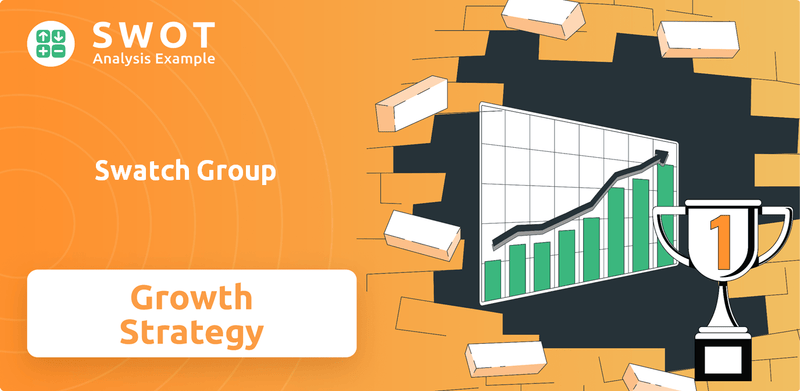
From its humble beginnings rescuing Swiss watchmaking from the quartz crisis, Swatch Group has built an empire of diverse Swatch Group Brands. Understanding Swatch Group's market share analysis and financial performance is crucial for predicting long term growth forecasts. This analysis considers the company's expansion strategies, new product development, and its response to challenges and opportunities within the competitive landscape, including the impact of smartwatches.
How Is Swatch Group Expanding Its Reach?
The Revenue Streams & Business Model of Swatch Group relies heavily on expansion initiatives to maintain its position in the luxury watch market. These initiatives are multifaceted, focusing on geographic expansion, product diversification, and strategic partnerships. The company's approach is designed to navigate the complexities of the global market and capitalize on emerging trends.
A key component of the Swatch Group's growth strategy involves penetrating new markets, particularly in Asia and the Middle East. These regions offer significant growth potential due to the increasing affluence of the middle class and a strong interest in luxury goods. The company's focus on these areas is strategic, aiming to capture a larger share of the growing consumer base.
Product diversification is another crucial aspect of the expansion strategy. The Swatch Group consistently introduces new collections and limited editions across its brand portfolio. This strategy helps attract new customers while keeping existing ones engaged. Collaborations, such as the MoonSwatch, have been particularly successful in boosting brand appeal and driving foot traffic to retail locations.
The Swatch Group is targeting emerging markets in Asia and the Middle East. These regions offer significant growth potential for both luxury and accessible watch segments. The company is focusing on strengthening its presence in China, despite recent challenges.
New collections and limited editions are regularly introduced across Swatch Group brands. Successful collaborations, like the MoonSwatch, boost brand appeal. The group explores opportunities in adjacent luxury segments, such as jewelry.
The Swatch Group leverages partnerships for smart features and other technological advancements. These collaborations help reach new customer segments. Strategic partnerships support revenue stream diversification.
The company strategically acquires brands that complement its existing portfolio. Acquisitions provide access to new technologies and market segments. The focus is on organic growth driven by product innovation and strong brand equity.
The Swatch Group's expansion strategies are multifaceted, focusing on both organic growth and strategic acquisitions. The company aims to strengthen its presence in key markets while diversifying its product offerings to meet evolving consumer demands. This approach is crucial for maintaining a competitive edge in the luxury watch market.
- Geographic Expansion: Focusing on emerging markets like China and the Middle East.
- Product Innovation: Regularly introducing new collections and limited editions.
- Strategic Partnerships: Collaborating on smart features and other technological advancements.
- Brand Acquisitions: Strategically acquiring brands to complement the existing portfolio.
Swatch Group SWOT Analysis
- Complete SWOT Breakdown
- Fully Customizable
- Editable in Excel & Word
- Professional Formatting
- Investor-Ready Format
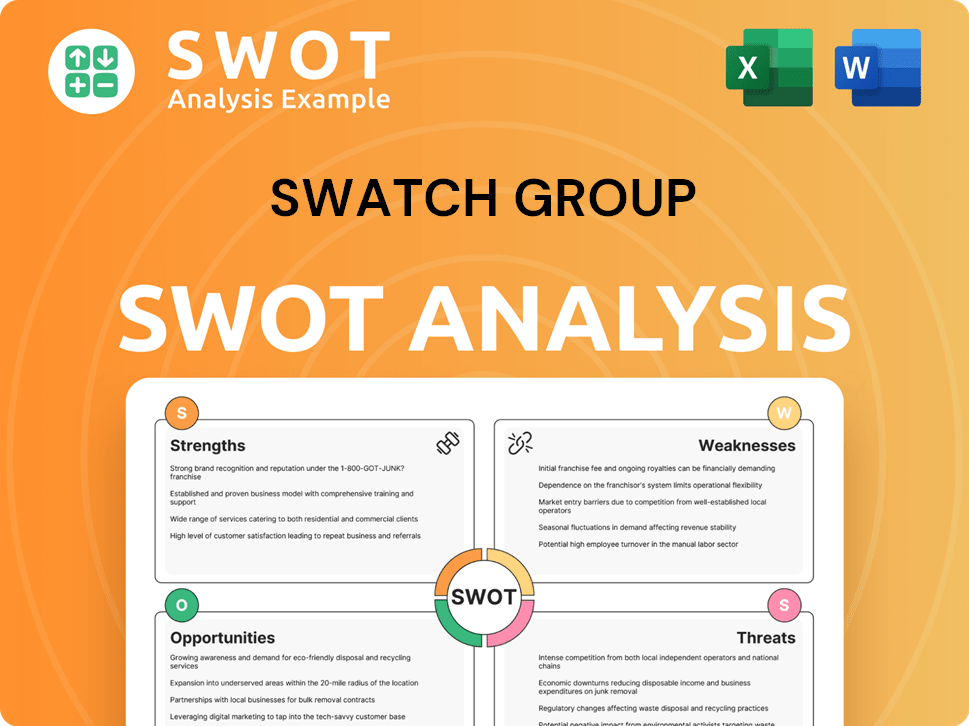
How Does Swatch Group Invest in Innovation?
Innovation and technology are pivotal to the sustained growth of the Swatch Group. The company's commitment to research and development (R&D) is substantial, driving advancements across its diverse brand portfolio. This dedication underscores its ability to maintain a competitive edge in the luxury watch market and beyond.
The company's approach to digital transformation is comprehensive, integrating cutting-edge technologies while preserving its heritage of Swiss watchmaking. This strategy allows for the enhancement of product capabilities and operational efficiency, ultimately contributing to its growth objectives. Swatch Group's focus on innovation is evident in its investments and strategic initiatives.
The company’s in-house development capabilities, particularly within its ETA movement manufacturing arm, are a key strength. ETA is a global leader in watch movements, continuously advancing mechanical movements, quartz technology, and precision engineering. This internal expertise allows for greater control over product quality and innovation.
Swatch Group has integrated smart features, such as NFC payment capabilities, into certain Swatch models. This demonstrates a commitment to incorporating smart functionalities where they enhance the user experience. This approach balances innovation with the traditional watchmaking ethos.
Unlike some competitors, Swatch Group does not fully embrace the 'smartwatch' trend. Instead, it focuses on providing connectivity and smart functionalities that enhance the core identity of its timepieces. This approach is designed to cater to the preferences of its target demographic.
Sustainability is a growing focus, with efforts in developing eco-friendly materials and manufacturing processes. This commitment reflects a broader industry trend toward environmental responsibility. These initiatives are important for long-term brand value.
The company holds numerous patents in areas like materials science and microelectronics. This underscores its leadership in innovation. Patents protect its unique technologies and contribute to its competitive advantage.
Technological advancements contribute to enhanced product performance and appeal. They also allow for more efficient production processes, which supports growth objectives. This dual focus is central to its innovation strategy.
Swatch Group's substantial R&D investments are a key indicator of its commitment to innovation. These investments drive the development of new products and technologies. This sustained investment is critical for long-term growth.
Swatch Group's approach to innovation and technology is multifaceted, focusing on both product enhancements and operational efficiencies. The company strategically integrates new technologies while maintaining its core values of quality and craftsmanship. This balance is crucial for its continued success in the luxury watch market.
- In-House Movement Manufacturing: ETA, a key component, ensures quality control and innovation in watch movements.
- Smart Feature Integration: Strategic incorporation of NFC payment and other smart functionalities.
- Sustainability: Development of eco-friendly materials and manufacturing processes.
- Intellectual Property: A strong portfolio of patents in materials science and microelectronics.
Swatch Group PESTLE Analysis
- Covers All 6 PESTLE Categories
- No Research Needed – Save Hours of Work
- Built by Experts, Trusted by Consultants
- Instant Download, Ready to Use
- 100% Editable, Fully Customizable
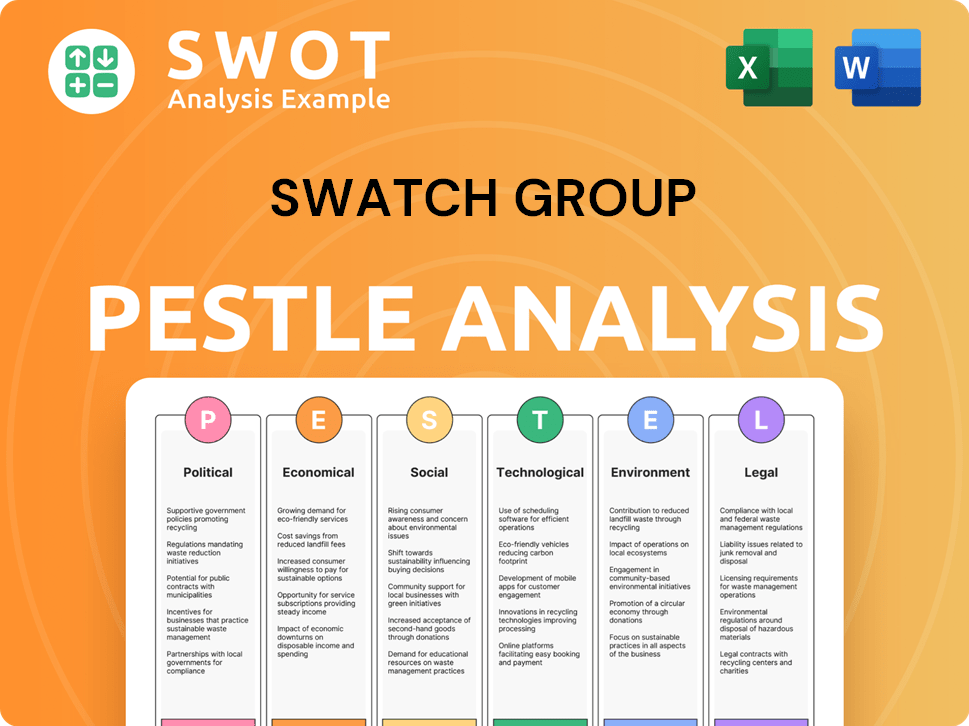
What Is Swatch Group’s Growth Forecast?
The financial outlook for the Swatch Group is centered on a strategy that emphasizes maintaining strong profit margins and making disciplined investments. The company's approach involves careful management of its diverse brand portfolio to navigate global economic uncertainties effectively. Recent financial reports offer a glimpse into the company's performance and future direction, underscoring its commitment to sustainable growth.
For the first half of 2024, the Swatch Group reported a net sales increase of 5.8% at constant exchange rates, reaching CHF 4,019 million. This growth reflects the company's ability to adapt and thrive in various market conditions. The operating profit for the same period rose by 12.6% to CHF 686 million, with net income increasing by 18.0% to CHF 597 million. These figures demonstrate the company's effective operational strategies and financial management.
The Swatch Group's financial strategy is geared towards steady, sustainable growth, balancing market share gains with profitability. The company's financial ambitions are generally aligned with cautious optimism, recognizing global economic uncertainties while leveraging its diversified brand portfolio to mitigate risks. Investment levels are focused on R&D, brand building, and optimizing its retail network, including e-commerce platforms. The company maintains a robust balance sheet, providing flexibility for strategic investments and managing potential economic headwinds. This financial narrative emphasizes the strength of its luxury brands, the resilience of its accessible brands, and the ongoing efforts to enhance operational efficiency. For more insights into their approach, consider reading about the Marketing Strategy of Swatch Group.
The Swatch Group's market share in the Luxury Watch Market is a key indicator of its success. The company's diverse brand portfolio allows it to cater to a wide range of consumer preferences and price points. This broad appeal helps the Swatch Group maintain a strong position in the competitive landscape.
The financial performance of the Swatch Group is closely watched by investors and industry analysts. The company's ability to consistently deliver strong financial results, as seen in the first half of 2024, reflects its effective management and strategic planning. Key metrics include revenue growth, profit margins, and net income.
Swatch Group's expansion strategies involve both organic growth and strategic initiatives. This includes expanding its retail presence in key markets and enhancing its e-commerce capabilities. The company also focuses on new product development to stay ahead of market trends.
Innovation in watchmaking is a cornerstone of the Swatch Group's strategy. The company invests heavily in R&D to create new products that appeal to a wide range of consumers. This includes both traditional mechanical watches and more modern designs.
Sustainability is becoming increasingly important for the Swatch Group. The company is taking steps to reduce its environmental impact and promote responsible practices. This includes sustainable sourcing and manufacturing processes.
The Swatch Group's online sales strategy is a key component of its growth plan. The company is investing in its e-commerce platforms to reach a wider audience. This includes improving the customer experience and expanding its digital marketing efforts.
Understanding customer demographics is crucial for the Swatch Group. The company targets a diverse range of consumers, from luxury watch enthusiasts to those seeking accessible brands. This broad appeal helps drive sales.
The Swatch Group operates in a highly competitive environment. Key competitors include other major watch manufacturers and luxury goods companies. The company's brand portfolio and strategic initiatives help it maintain a competitive edge.
Innovation in watchmaking is central to the Swatch Group's identity. The company continuously explores new technologies and designs to create unique and desirable products. This includes advancements in materials and movements.
The Swatch Group faces various challenges and opportunities in the market. These include economic uncertainties, changing consumer preferences, and the rise of smartwatches. The company's strategic approach helps it navigate these challenges.
Swatch Group Business Model Canvas
- Complete 9-Block Business Model Canvas
- Effortlessly Communicate Your Business Strategy
- Investor-Ready BMC Format
- 100% Editable and Customizable
- Clear and Structured Layout
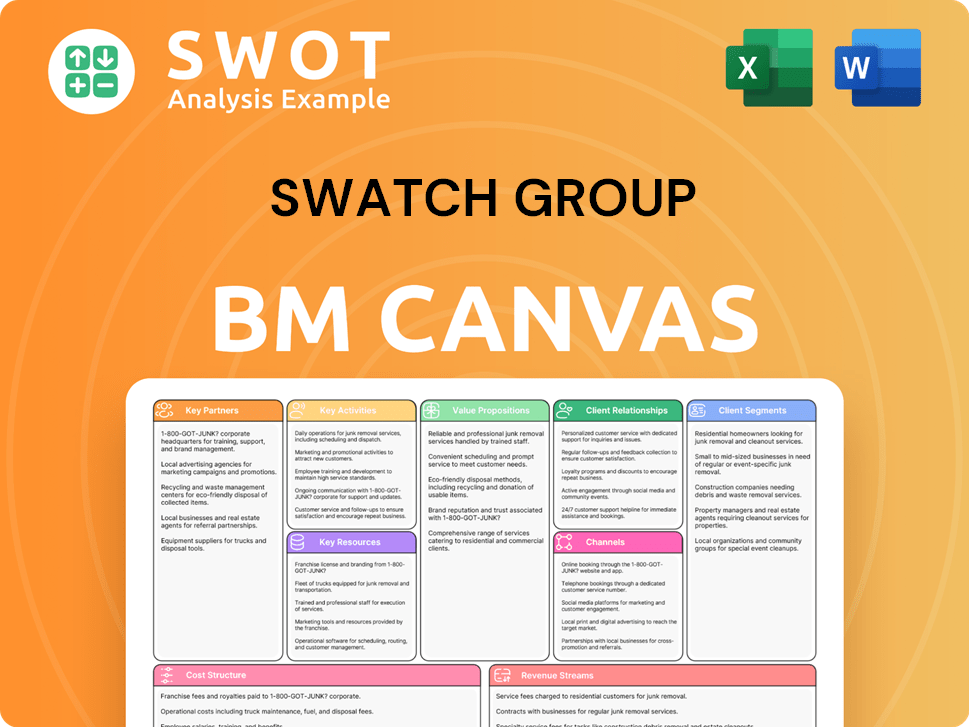
What Risks Could Slow Swatch Group’s Growth?
The Swatch Group faces several obstacles that could impact its plans for future expansion and market dominance. These challenges range from intense competition in the luxury watch market to the need for continuous innovation to stay ahead of technological advancements. Understanding these potential risks is crucial for evaluating the company's long-term prospects and its ability to maintain its position within the Swiss watchmaking industry.
Several external factors, including changes in global economic conditions and shifts in consumer preferences, could also pose significant challenges. The company must also navigate complex supply chain issues and adapt to evolving regulatory landscapes. Effective risk management and strategic planning are essential to mitigate these potential impacts and ensure sustained growth across its diverse portfolio of Swatch Group brands.
The company's ability to adapt to the rise of smartwatches and other wearable technologies is crucial. The evolving competitive landscape demands constant innovation and a keen understanding of consumer behavior. The company's strategies must also account for the impact of geopolitical tensions and the increasing importance of environmental, social, and governance (ESG) factors.
The Swatch Group competes against established luxury brands and emerging smartwatch manufacturers. Continuous innovation and strong brand differentiation are essential to maintain market share. The company's ability to balance traditional watchmaking with technological advancements is key.
Changes in international trade regulations and luxury goods taxes can significantly affect the company's supply chains and market access. The company must navigate complex regulatory environments in various regions. Compliance costs and potential trade barriers pose financial and operational risks.
Disruptions in the supply chain for critical components and raw materials can impact production and sales. Recent global events have highlighted the importance of diversified suppliers and strategic inventory management. The company needs robust contingency plans to mitigate supply chain risks.
The rapid evolution of technology, especially in the wearable device market, presents a significant risk. Failure to adapt to changing consumer preferences for connected devices could harm the company's market position. Investment in R&D and digital capabilities is crucial.
Attracting and retaining skilled talent in specialized fields like micro-engineering and digital marketing can be challenging. These skills are vital for innovation and competitiveness. The company must invest in training and development to address talent gaps.
Geopolitical tensions and economic downturns can affect consumer spending in key markets. The company's performance is closely linked to global economic stability and consumer confidence. Diversification across markets is essential to mitigate these risks. According to the latest reports, the luxury watch market saw a decrease in sales in certain regions due to economic uncertainties in 2024.
The Swatch Group employs a comprehensive risk management framework, including scenario planning and contingency measures. This framework helps the company identify, assess, and manage various risks effectively. The company actively monitors market trends and consumer behavior to adapt its strategies.
The company actively manages its inventory levels to align with demand fluctuations, minimizing risks associated with overstocking or shortages. Investment in e-commerce capabilities allows the company to adapt to shifts in retail landscapes and reach a broader customer base. Online sales have increased, representing a significant portion of the company's revenue in recent years.
Increasing scrutiny on environmental, social, and governance (ESG) practices requires ongoing adaptation and investment. The company is focusing on sustainable sourcing, ethical labor practices, and reducing its environmental footprint. The integration of ESG factors is becoming increasingly important for brand reputation and investor relations.
The company's strategic initiatives include continuous product innovation, brand diversification, and expansion into emerging markets. The Swatch Group is also exploring strategic partnerships and acquisitions to strengthen its market position. For instance, the company has increased its investment in digital marketing to enhance customer engagement.
For more detailed insights into the company's history and market position, you can refer to Brief History of Swatch Group. Understanding these risks and the strategies to mitigate them is critical for assessing the Swatch Group's long-term growth potential and its ability to navigate the complexities of the luxury watch market.
Swatch Group Porter's Five Forces Analysis
- Covers All 5 Competitive Forces in Detail
- Structured for Consultants, Students, and Founders
- 100% Editable in Microsoft Word & Excel
- Instant Digital Download – Use Immediately
- Compatible with Mac & PC – Fully Unlocked
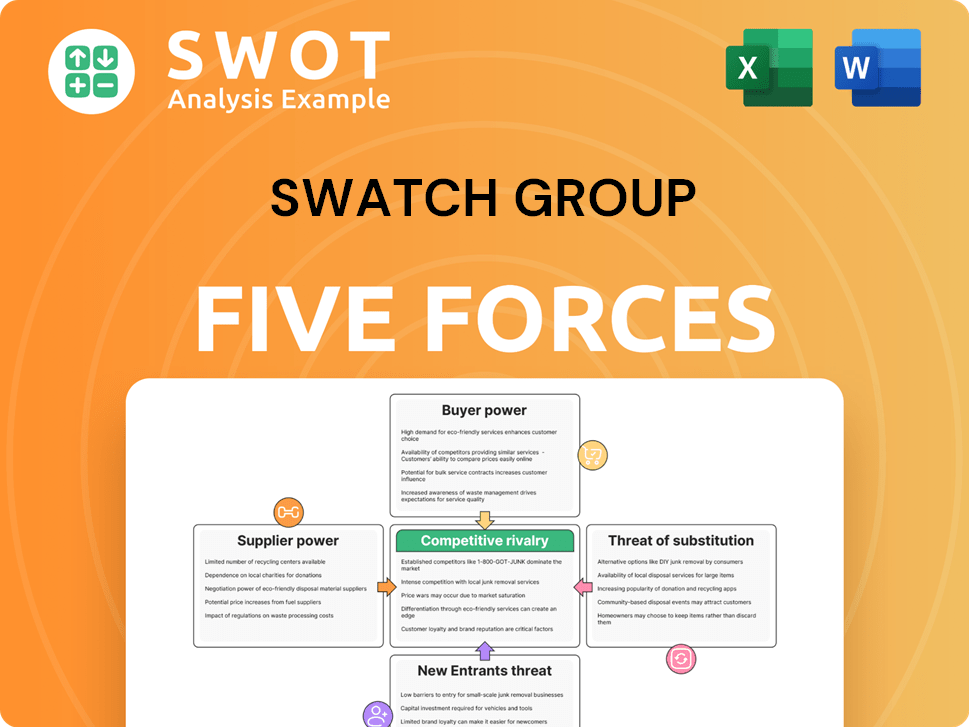
Related Blogs
- What are Mission Vision & Core Values of Swatch Group Company?
- What is Competitive Landscape of Swatch Group Company?
- How Does Swatch Group Company Work?
- What is Sales and Marketing Strategy of Swatch Group Company?
- What is Brief History of Swatch Group Company?
- Who Owns Swatch Group Company?
- What is Customer Demographics and Target Market of Swatch Group Company?
Disclaimer
All information, articles, and product details provided on this website are for general informational and educational purposes only. We do not claim any ownership over, nor do we intend to infringe upon, any trademarks, copyrights, logos, brand names, or other intellectual property mentioned or depicted on this site. Such intellectual property remains the property of its respective owners, and any references here are made solely for identification or informational purposes, without implying any affiliation, endorsement, or partnership.
We make no representations or warranties, express or implied, regarding the accuracy, completeness, or suitability of any content or products presented. Nothing on this website should be construed as legal, tax, investment, financial, medical, or other professional advice. In addition, no part of this site—including articles or product references—constitutes a solicitation, recommendation, endorsement, advertisement, or offer to buy or sell any securities, franchises, or other financial instruments, particularly in jurisdictions where such activity would be unlawful.
All content is of a general nature and may not address the specific circumstances of any individual or entity. It is not a substitute for professional advice or services. Any actions you take based on the information provided here are strictly at your own risk. You accept full responsibility for any decisions or outcomes arising from your use of this website and agree to release us from any liability in connection with your use of, or reliance upon, the content or products found herein.